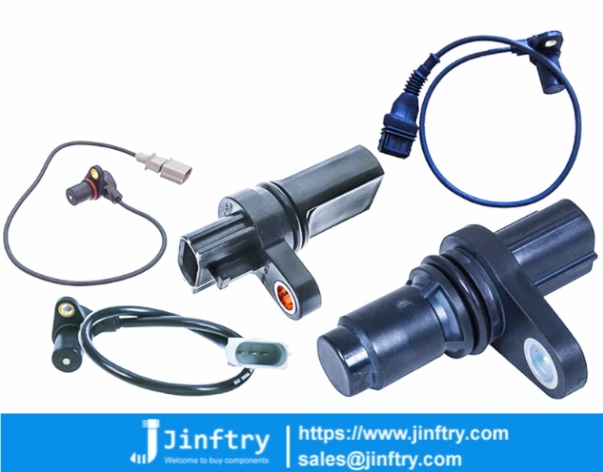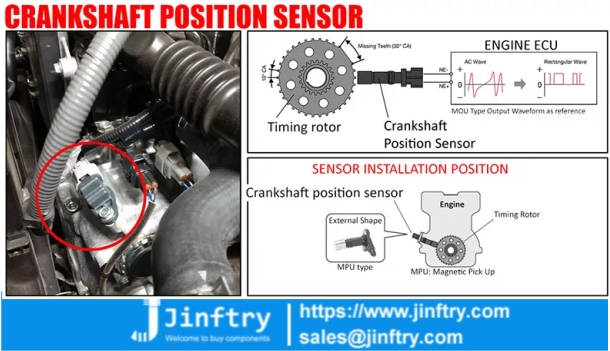Crankshaft Position Sensor: Definition, Common Symptoms and Test Methods

Crankshaft Position Sensor Definition

In modern car engines, the crankshaft position sensor (CPS) plays a vital role. It is an electronic sensor that monitors the rotational position and speed of the crankshaft to determine the position of the engine piston and the engine speed. This information is critical to the engine control unit (ECU) because it needs this data to accurately control the timing of the ignition system and the fuel injection system.
How Crankshaft Position Sensor Works

Crankshaft position sensors are generally available in three types of technology:
1. Magnetic pulse type: This type of sensor contains a coil and a magnet. When the gear or wheel on the crankshaft passes the sensor, the magnetic field of the magnet is disturbed, generating detectable voltage pulses. The ECU uses these pulses to determine the position and speed of the crankshaft.
2. Photoelectric type: Photoelectric sensors use a light source and a light receiver. There is a wheel with a hole on the crankshaft. When the hole passes between the light source and the receiver, the receiver receives light, thereby generating a signal.
3. Hall type: Hall effect sensors use magnetic fields to generate electrical signals. When the crankshaft wheel with permanent magnets rotates, the change in magnetic field causes the Hall element to generate a voltage signal.
The role of the crankshaft position sensor
- Provides key information for ignition timing and injection timing.
- Monitor engine speed.
- In conjunction with the camshaft position sensor, it determines the piston position and working cycle of each cylinder, namely the compression, ignition, expansion and exhaust stages.
Common fault symptoms of the crankshaft position sensor
When the crankshaft position sensor fails, the vehicle may exhibit a series of problems, including but not limited to:
- Difficult starting: The engine may be difficult to start because the ECU cannot accurately identify the crankshaft position.
- Unstable operation: Ignition and fuel injection inaccuracies may cause unstable engine operation, manifested as idle fluctuations or slow acceleration.
- Stalling: The engine may suddenly stall during driving, especially under high load or high speed.
- Engine fault light is on: The engine warning light on the instrument panel may be on, indicating that there is a sensor-related problem
- Increased fuel consumption: The vehicle's fuel economy may be affected due to reduced combustion efficiency.
- Reduced power: The engine performance is weakened and the acceleration response is slow.
How to Test a Crankshaft Position Sensor
When you suspect a crankshaft position sensor is faulty, there are several ways to test it:1.Visual Inspection:
- Inspect the sensor and its connector for physical damage, such as cracks, corrosion, or loose connections.
- Check the area around the sensor to remove any oil or debris, as these may affect its performance.
2.Use an OBD-II Scan Tool:
- Connect an OBD-II diagnostic scanner to the vehicle's diagnostic port and read any stored fault codes. Codes associated with the crankshaft position sensor often indicate a possible problem with the component.
- Observe the crankshaft position sensor signal in a live data stream to ensure that its reading changes as the engine speed changes.
3.Resistance Measurement:
- Use a digital multimeter (DMM) to measure the resistance value of the sensor. Disconnect the sensor plug and refer to the data sheet provided by the vehicle manufacturer to confirm that the resistance value is within the specified range.
4.Waveform Analysis:
- For advanced diagnostics, an oscilloscope can be used to examine the waveform output by the sensor. A normal waveform should show clear peaks and valleys, and an abnormal waveform may indicate a sensor failure.
5.Replacement Test:
- If the above test indicates that the sensor may be faulty, the most reliable method is to replace a new crankshaft position sensor and observe whether the vehicle performance returns to normal.
Before performing any tests, it is recommended to refer to the specific repair manual of the vehicle, as different manufacturers and models may have different sensor types and test procedures. If you are unsure of what to do, it is best to have it inspected and repaired by a professional mechanic to avoid potential safety risks and further damage.
Statement
All articles (images, texts, audio) on this site are uploaded and shared by users, or integrated from relevant internet sources, only for user's learning. If your rights are violated, please contact the administrator to delete! Link to this article: https://www.jinftry.com







